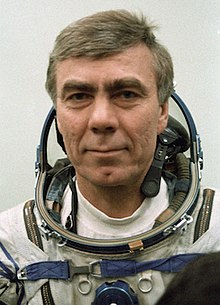

Anatoly Semyonovich Levchenko
| |
|---|---|

Levchenko in 1987
| |
| Born | (1941-05-09)May 9, 1941 |
| Died | 6 August 1988(1988-08-06) (aged 47) |
| Nationality | Soviet |
| Occupation | Test Pilot |
| Awards | Hero of the Soviet Union |
| Space career | |
| Cosmonaut | |
| Rank | Captain, Soviet Air Force |
Time in space | 7d 21h 58m |
| Selection | 1988 Cosmonaut Group |
| Missions | Mir LII-1 (Soyuz TM-4 / Soyuz TM-3) |
Anatoly Semyonovich Levchenko (Russian: Анатолий Семёнович Левченко; May 5, 1941 – August 6, 1988) was a Soviet cosmonaut in the Buran programme.
Trained as a test pilot and selected as a cosmonaut on 12 July 1980,[1] Levchenko was planned to be the back-up commander of the first Buran space shuttle flight. As part of his preparations, he also accomplished test-flights with Buran's counterpart OK-GLI aircraft.
In March 1987, Levchenko began extensive training for a Soyuz spaceflight, intended to give him some experience in space.[2] In December 1987, he occupied the third seat aboard the spacecraft Soyuz TM-4 to the space station Mir, and returned to Earth about a week later on Soyuz TM-3. His mission is sometimes called Mir LII-1, after the Gromov Flight Research Institute shorthand.[3]
In the year following his spaceflight, Anatoly Levchenko died of a brain tumor, in the Nikolay Burdenko Neurosurgical Institute in Moscow.[4]
He was married with one child.[1]
He was awarded the titles of Hero of the Soviet Union and Pilot-Cosmonaut of the USSR and the Order of Lenin.
|
Pilot test groups selected for the Soviet Buran programme
| |
|---|---|
| First pilot test group of LII (July 12, 1977) |
|
| Second group of LII (1982-1985) |
|
This article about an astronaut is a stub. You can help Wikipedia by expanding it. |
This Soviet biographical article is a stub. You can help Wikipedia by expanding it. |
This biographical Hero of the Soviet Union article is a stub. You can help Wikipedia by expanding it. |